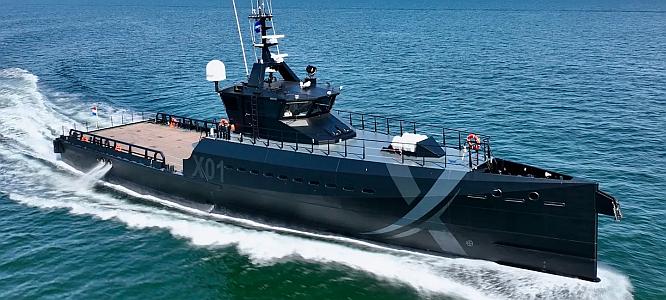 NavyX’s new maritime sandbox, XV Patrick Blacket, was christened today in Portsmouth, UK with the help of a robotic dog.
NavyX’s new maritime sandbox, XV Patrick Blacket, was christened today in Portsmouth, UK with the help of a robotic dog.
You might well ask, what is NavyX? What is a maritime sandbox? And what about the robotic dog?
Navy X
NavyX describes itself as “the Royal Navy’s Autonomy and Lethality Accelerator, which rapidly develops, tests, and trials cutting-edge equipment, with the aim of getting new technology off the drawing board and into the hands of our people on operations at a pace.”
NavyX has a new ship, the XV (Experimental Vessel) Patrick Blackett, that is described variously as a “maritime sandbox” and a “testbed ship,” intended to support trials of the latest tech and autonomous systems.
XV Patrick Blacket
The XV Patrick Blacket is a 42m, 270-tonne vessel, based on a Damen 4008 Fast Crew Supply ship, modified for the RN’s needs. The ship is named after former Royal Navy sailor and Nobel Prize-winning experimental physicist Patrick Blackett.
XV Patrick Blackett will enable NavyX to experiment without the need to place demands on other navy ships, many of which are deployed permanently away from UK waters. She will also offer the chance to work closely with industry and academia partners.
The ship, with a crew of five Royal Navy personnel, will have a “plug and play” element to support the navy’s new PODS (Persistently Operationally Deployed Systems) concept which means it can be adapted to the specific trials or experiments it’s carrying out including testing drones and autonomous vessels and AI decision-making.
Colonel Tom Ryall, Head of NavyX, said: “The arrival of this vessel is a pivotal moment for NavyX’s ability to deliver output for the Royal Navy.
“She will give us greater flexibility to experiment with novel military capabilities, and accelerate new technology, kit, and concepts to the frontline.”
The Robot Dog
But what about the robot dog? At the XV Patrick Blackett christening ceremony in Portsmouth this morning, a robot dog was chosen to swing a bottle of champagne against the ship’s bow.
As is often the case with new technology, not everything went according to plan. The robot dog performed as intended, pulling a line, which caused the champagne bottle to swing and hit the ship’s stem. The problem was the champagne bottle didn’t break.
The lesson to be learned from the unbroken bottle has little to do with advanced technology and everything to do with traditional skills. Champagne bottles are designed to be difficult to break. Bottles used for christening are routinely scored with a glass cutter to make them sure to shatter when they hit the hull. (If a glass cutter is not handy, specially scored christening bottles are available for sale at many marine supply stores.)
XV Patrick Blackett formally named & blue ensign raised.
Can exclusively reveal the robot dog did the business but the champage bottle did not break.
Worked fine in rehearsal but todays issues quite in keeping with "fast to fail" iterative development philosophy of @RNNavyX 🙂 pic.twitter.com/uuwXn2wmgK
— Navy Lookout (@NavyLookout) July 29, 2022
Thanks to Alaric Bond and David Rye for contributing to this post.

Evidence that the first experiment was a success!
https://twitter.com/RNNavyX/status/1553035783984005121
I’m confused by the use of a Blue Ensign on an RN ship. RN vessels usually fly the White Ensign.
For a Photo Essay please see:
https://www.navylookout.com/photo-essay-onboard-the-xv-patrick-blackett/
J-P:
The XV is intended to have a distinctive appearance, she is not painted pussers grey, but matt back, carrying a large NavyX logo, and the pennant number X01 highlighted in gloss. She will not be a commissioned vessel but will serve under the Blue Ensign, being an unarmed, government-owned vessel simplifies her operation and the way she could be employed.
A large QR code will be painted on each side of the superstructure to give smartphone users a link to a website of NavyX’s choice. An excellent way to promote public engagement and provide a timely explanation of the work being undertaken. She will attend both RN and NATO exercises around the UK and abroad and is a flexible platform that will provide a broad range of experimentation options for NavyX and wider industry.
@David Rye: Thank you for the explanation